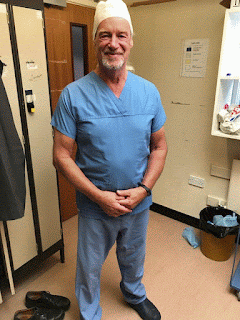I am a great believer in serendipity.
When thinking about this week’s blog, I found myself ‘stuck’ on the news of the
appointment of Lord David Prior as the Chair designate for the NHS England. I
say ‘stuck’, as I wanted to say something about my dismay at his appointment
and what I thought it might mean for the NHS, but also pulled away from
developing such a narrative, as I try to avoid political commentary in my
blogs. Lord Prior is well known in the NHS. He was the former Chair of the Care
Quality Commission (CQC) before stepping down to take up the role of Under Secretary
of State for Health in the previous Conservative government. He has held Chair positions
at a couple of NHS trusts, and currently remains Chair of University College
London Hospital (UCLH) NHS Trust.
I found it interesting that, despite
what I thought was the hospital’s and associated medical school’s well-deserved
international reputation, the UCLH was only given a ‘Good‘ rating by the CQC at
its last assessment. More interestingly still (at least for me as a researcher and
academic) was that UCLH was only ranked 40th in the UK and 607th
in the world by the Ranking Web of World Hospitals*, whereas Wrightington,Wigan and Leigh (WWL) NHS Trust, where I sit as a Non-Executive Director (NED),
is ranked 27th in the UK and 503th in the world (*other
ranking organisations are available).
It’s at WWL where last week’s serendipitous
experience happened. I was sitting in the car park waiting to go into a meeting
and as I was early, I decided to start to write up my blog notes on the inappropriateness
of Lord Prior’s appointment - the original focus for this week’s blog. I noted
that he had made a number of controversial comments on the NHS and healthcare
during his career – including that… continuing to fund the NHS through taxes ‘must
be questioned’ and that ‘even God would struggle to manage the NHS due to its
size‘. I am not sure of the degree of independence he can bring to the role and
it certainly looks like his appointment is another example of the creeping politicisation
of the NHS.
Although my heart wasn’t in it, I
promised myself I would return to the notes in due course, and closed my laptop
and went to meet my colleagues. I was at Wrightington Hospital, part of the WWL
family, and a hospital with an international reputation for orthopaedics. I was
there to undertake a Leadership Safety Walkabout. These are regular events in
our hospital calendar and an opportunity for Executive, Non-Executive Directors
and Governors to visit clinical areas and meet the colleagues working there.
This visit was to the theatre suites. After meeting my other walkabout
colleagues, I was asked to change into surgical scrubs – which sadly for me (as
I always wear black) only came in a fetching duck egg blue.
We were taken on a ‘patient journey’,
which as well as being a great way of gaining an understanding of how the theatres
operated (sorry), also provided our hosts with the opportunity to give us a
brilliant history lesson on how services at Wrightington have developed. The
person most associated with this history is the late Sir John Charnley. In 1958,
he pioneered the first hip replacement operation. This is now one of the most
common operations undertaken globally. The first recorded attempt at hip replacement
was carried out in Germany in 1891 (a crude operation that used nickel screws, Plaster
of Paris and glue). The first metallic hip replacement surgery was undertaken
in the US. However, it was Charnley’s dedication to research, science, and
collaboration with biomechanics, which had the biggest influence on
contemporary orthopaedics.
He created the Wrightington
Centre for Hip Surgery, and has educated generations of orthopaedic surgeons
through his textbook on conservative fracture treatment. In the early days, he
persuaded 99% of his patients to let him have the ‘hips’ back when they died.
These he tested for wear and tear and this information allowed him to refine the
design of his implants and approaches to fixing them. This research and
development meant that by 1970, Charnley’s design almost completely replaced
all other designs.
His presence is still very tangible
within the theatres. He created an isolation zone within which to operate –
this is now replaced by a similar sterile zone enabled through pressurised air.
Everyone I met during the walkabout held his work in great regard. There was great
pride in the work they do, and in the sense of belonging they all shared. At
the group discussion in the coffee lounge, the conversation was wide-ranging.
What stood out was the shared consensus that the NHS was still the best way to
provide specialist health care, and the NHS was better kept as a public service
– Lord Prior take note! Getting back to my car I deleted the notes I had previously
made and knew then what I wanted to write about in this week’s blog…
Ps – this week’s blog is
dedicated to my friend, colleague and fellow NED, Neil Campbell, who very sadly
and suddenly died last weekend. His contribution to health and social care has
been phenomenal, both in Scotland and here in Greater Manchester. He will be
greatly missed and my thoughts are with his family at this sad time.

No comments:
Post a Comment